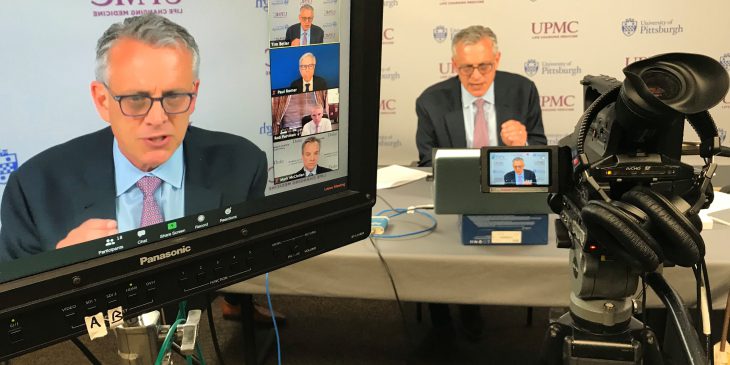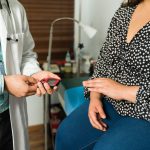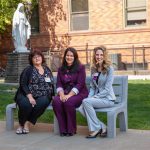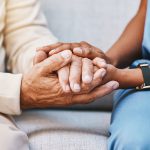Dr. Steven Shapiro, UPMC’s chief medical and scientific officer, participated in a virtual roundtable convened by U.S. Senator Pat Toomey (R-Pa.), chairman of the Senate Finance Committee Subcommittee on Health Care, on May 6 to explore the issue of reopening the economy. Following are his remarks:
I would like to thank Senator Toomey and the committee members for the opportunity to share a typical health care experience of COVID-19 through the lens of UPMC, whose hospitals span urban, community and rural areas comprising the largest academic health system in the country and a health plan with 3.8 million subscribers.
As we prepared for the pandemic, we radically transformed our hospital operations to create a safe environment for patients and staff, we delayed non-urgent surgery, reducing it by 70%, and we scaled up telemedicine 38-fold, performing 250,000 visits in April.
We indeed saw a steady stream of patients but never “surged.” At peak in mid-April, COVID-19 patients occupied 2% of our 5,500 hospital beds and 48 of our 750 ventilators. Subsequently, admissions have been decreasing with very few patients now coming from the community, almost all now being from nursing homes. Of note, in the 36 UPMC-owned senior facilities we have had zero positive cases.
Our outcomes are similar to the state of Pennsylvania, where the median age of death from COVID-19 is 84 years old. The few younger patients who died all had significant preexisting conditions. Very few children were infected and none died. Minorities in our communities fared equally as well as others, but we know that this is not the case nationally. In sum, this is a disease of the elderly, sick and poor.
We are now actively bringing back our patients for essential care following CMS guidelines. To assure a safe environment, we use adequate PPE and test all, even asymptomatic, preoperative patients for active viral infection with PCR. To date, 0 out of 1,000 tested positive in western Pennsylvania, New York and Maryland. 3 of 500 are positive in central Pennsylvania. Our community prevalence is low, which we will soon confirm with antibody testing.
Of course, we still need effective prevention and therapy. The scientific community has never worked so rapidly or collaboratively. UPMC and Pitt, home of Jonas Salk, has been in the thick of it. Intense efforts are underway to find antibodies that bind to the virus and prevent it from entering cells. Crude antibody-rich convalescent plasma is already being administered to patients, while development of highly effective synthetic antibodies and vaccines is moving at breakneck speed.
Despite rapid progress, there are critical gaps in our knowledge as well as selective use of what we know. For example, we don’t know why many who are infected never develop symptoms while other, seemingly similar patients, get very sick. Crowded indoor conditions can be devastating in nursing homes, while on the USS Theodore Roosevelt 1,102 sailors were infected, but only 7 required hospitalization, with 1 death. This contrast has significant implications that we have not embraced. Epidemiologic prediction models have performed poorly often neglecting critical variables. Seasonality is rarely considered, yet we know that coronaviruses are seasonal. Hope is not a plan, but it is quite possible that the virus is not very healthy in the U.S. right now.
The question before us is what will happen as we re-open society and how should we manage it? For New York and a handful of other cities with high case rates as a result of density, travel and socioeconomic issues, they must open up in a measured step-wise manner with extensive testing, tracing and treatment.
But for the rest of the country, as people come out of their homes cautiously and safely, if we protect our vulnerable seniors, particularly those in nursing homes, we should be able keep case rates low, buying time for a potential resurgence as we bolster our supply chain and find effective intervention.
COVID-19 is a disease that ravages those with preexisting conditions – whether it be immunosenescence of aging or the social determinants of health. We can manage society in the presence of this pathogen if we focus on these preexisting conditions.
What we cannot do, is extended social isolation. Humans are social beings, and we are already seeing the adverse mental health consequences of loneliness, and that is before the much greater effects of economic devastation take hold on the human condition.
This has been a wake-up call for our health care system and our nation in general. Health care workers have stepped up to the challenge, and we will be here to help our society reemerge safely and scientifically. One thing is certain: pandemics will be part of our future, and we must be better prepared. We can’t be put in a position to have to choose between death by pathogen or death by our economy.
In this particular case, the problem we’re not going to be able to fix in the short term is the complete eradication of the virus. The problem we can fix is to serve and protect our seniors, especially those in nursing homes. If we do that, we can reopen society, and though infectious cases may rise as in the Theodore Roosevelt, the death rate will not, providing time for the development of treatments and vaccines.









